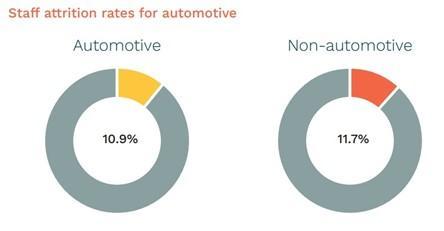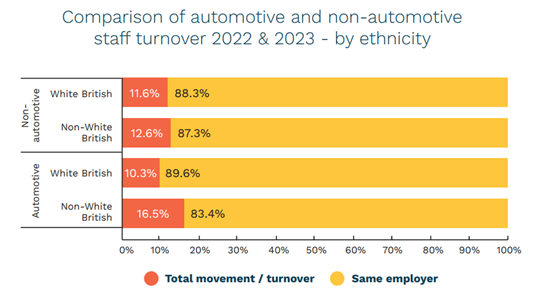Attrition and Diversity Trends in the Automotive Sector

Emma Carrigy , Head of Research, Careers and Inclusion
The automotive industry is undergoing its biggest, and most exciting, period of change since the invention of the internal combustion engine, thanks to the electrification and automation of vehicles. Yet despite this, the UK sector is seeing record levels of vacancies, with 4.3 vacancies for every 100 employees.
With vacancies already high, and the cost of hiring new staff putting pressure on budgets which have already been impacted by inflationary pressures, it’s important now more than ever to understand the attrition rate of the automotive sector.
Attrition rates serve as a barometer for gauging the health of a sector, or an organisation's, workforce. The most recent stats, as highlighted in the IMI’s latest report ‘Driving Towards Inclusion: Sector Report’, shows the sector's attrition rate standing at 10.9%. While this is 0.8% lower than non-automotive sectors, the industry still grapples with turnover challenges, as proved by the ‘big resignation’ during the pandemic. The data also further highlights that the sector is struggling to attract new, diverse talent, with vacancies rates remaining stubbornly high, despite falling attrition rates.

Delving into diversity, the data reveals intriguing insights. While the attrition rate for females in automotive mirrors that of non-automotive sectors, it hints at a trend where once in a role, females tend to stay longer.
Moreover, the attrition rate among non-White British individuals, though notably higher than their White British counterparts, has seen a decrease from 18.7% in 2022 to 12.5% in 2023. This shift prompts questions about the impact of diversity on retention and a sense of belonging within the automotive workforce.

Amidst these challenges, the role of Equity, Diversity, and Inclusion (EDI) initiatives becomes paramount. Research underscores the importance of aligning organisational culture with employee values to bolster retention.
Studies show that a staggering 54% of the global workforce considers changing jobs due to feeling undervalued. Furthermore, a significant portion of employees express a desire for more respect, value, and support in the workplace. In this context, EDI efforts not only foster a culture of inclusion but also address key drivers of attrition.
Diversity, particularly, emerges as a decisive factor for job seekers. Two-thirds of prospective employees prioritise diversity when evaluating job opportunities. By championing diversity, organisations not only attract new and top talent but also cultivate an environment where employees feel pride, valued and respected, reducing attrition risks.
The automotive sector stands at a crossroads. It’s grappling with attrition challenges while navigating the imperative for diversity and inclusion. By embracing EDI initiatives and fostering a culture that values diversity, the industry can not only mitigate attrition risks but also thrive in an increasingly competitive landscape.

